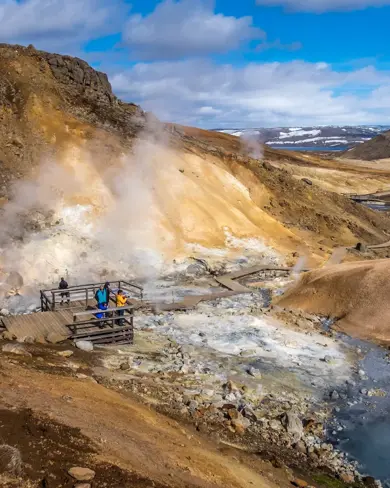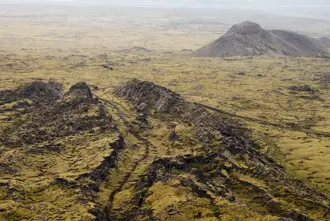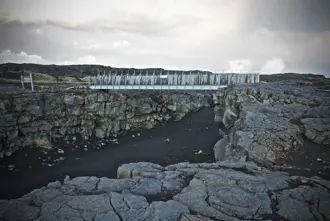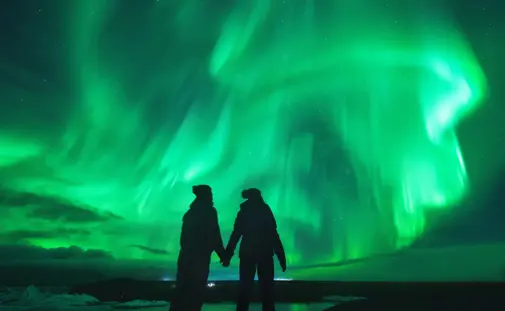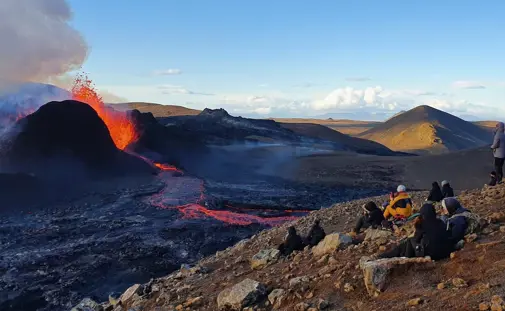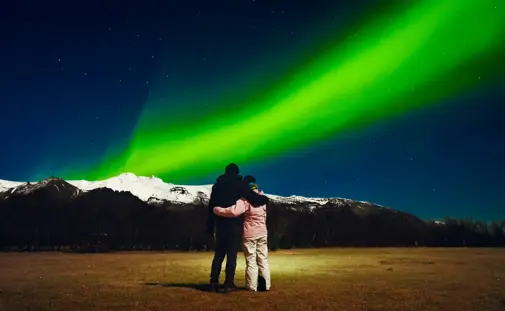Guide to Reykjanes Peninsula
Reykjanes Peninsula, located in southwestern Iceland, is a geologically active region known for its rugged landscapes, geothermal wonders, and proximity to the capital, Reykjavik. The peninsula is home to the famous Blue Lagoon, a geothermal spa with milky-blue waters rich in minerals, offering a relaxing retreat amidst a dramatic volcanic landscape. Reykjanes is also the site of the Reykjanes Geopark, a UNESCO Global Geopark, which showcases the area’s unique geological features, including fissures, lava fields, hot springs, and volcanic craters.
The peninsula is where the Mid-Atlantic Ridge rises above sea level, creating a dynamic landscape where the North American and Eurasian tectonic plates meet. Visitors can explore the dramatic Bridge Between Continents, which symbolizes the connection between these two plates. The region also features the active Fagradalsfjall volcano, which erupted recently, attracting global attention for its spectacular lava flows.
In addition to its geological attractions, Reykjanes offers cultural experiences, such as the Viking World museum, where visitors can learn about Iceland’s Viking heritage, and the charming fishing villages that dot the coastline. The peninsula’s rugged beauty, combined with its geothermal activity and cultural sites, makes Reykjanes a must-visit destination for those exploring Iceland’s diverse landscapes.
Facts & Figures
One of the most varied regions in Iceland, the Reykjanes Peninsula is 829 square kilometers (320 square miles). It forms an easy day trip for those visitors touring Southern Peninsula Iceland due to its proximity to Reykjavík, although at least one to two days should be given to devote ample time to the attractions this area has.
- Location: Southwest Iceland
- Area: 829 km² (320 mi²)
- Main attractions: Blue Lagoon, Gunnuhver Geothermal Area, Reykjanesviti Lighthouse
- Population: 22,000
- UNESCO Global Geopark: The Reykjanes Peninsula was designated a UNESCO Global Geopark in 2015 [1]
- Distance from Reykjavik: 50 kilometers (31 miles)
The peninsula is an outdoor enthusiast's dream, with activities ranging from hiking and birdwatching to exploring its volcanic landscapes. The latter has been shaped over millennia by this geothermal and volcanic activity — an opening into the forces that shaped Iceland itself.
Geology of Reykjanes Peninsula
The Reykjanes Peninsula is situated on the Mid-Atlantic Ridge, where the Eurasian and North American tectonic plates meet [2]. The ridge cuts through the peninsula, making the area one of the few in the world where visitors can take a walk between continents. The area is rich in volcanic activity; its scenery is dominated by lava fields, geothermal vents, and fumaroles. It’s also home to a number of active volcanoes, most recently August 22nd 2024 at Sundhnúksgígar [3], and previously the Fagradalsfjall eruption in 2021, both of which drew visitors from far and wide to see the spectacular flows of lava.
The Reykjanes geology is dominated by the Reykjanes Volcanic Belt, comprising a series of fissure swarms and volcanic systems. The lava fields are extensive; among these, Eldvörp gives a great example of the volcanic past of this peninsula [4]. There are numerous craters and areas of geothermal activity giving an unearthly quality to the landscape. That is why Reykjanes is one of the most singular regions in Iceland.
Geothermal & Volcanic Wonder
One of the distinguishing features of Reykjanes Peninsula comes in the form of geothermal energy disparities. The Gunnuhver Geothermal Field is among the biggest geothermal fields on the peninsula, where visitors find steam vents and bubbling mud pools. It got its name from a ghost named Gunna. According to local legend, she was thrown into these boiling hot springs.
The geothermal energy in the peninsula is tapped for the Svartsengi Power Station, which heats the waters to supply to the Blue Lagoon. Probably the most renowned geothermal spa even in Iceland, which attracts hundreds of thousands of visitors every year. The water in this lagoon is warm and milky blue in color, having high mineral content, especially silica, which many people believe has healing powers for skin diseases. The area around it consists of black lava flows, making this a peaceful and almost surreal spot.
Main Attractions
From geothermal fields to towering lighthouses, natural wonders fill the Reykjanes Peninsula. The most famous place of interest is Reykjanesviti Lighthouse, the oldest lighthouse in Iceland. Visitors can take walks from the lighthouse to see a panorama view of the coastline and Gunnuhver Geothermal Area.
Other attractions not to be missed include the Bridge Between Continents, where visitors can walk across a footbridge laid over the crack between the Eurasian and North American tectonic plates. This symbolic bridge vividly illustrates in a special way the peculiar geological position of Reykjanes.
For a more off-the-beaten-path experience, explore the Kleifarvatn Lake, one of the largest lakes on the peninsula, surrounded by volcanic mountains. The rugged and cloudy environment here presents a mystique that attracts the quiet mind looking for some very serene space far from the more touristy locations.
Map of Reykjanes Peninsula & Attractions
Wildlife on Reykjanes Peninsula
The Reykjanes Peninsula is a haven for birdwatchers. Seabirds like puffin, guillemot, and Arctic tern nest on the cliffs along the coast [5]. Visitors can see a thousand birds lining the cliffs in the nesting season. Birdwatching is especially popular in the late spring and summer months, from May to August, when the puffins return to the cliffs to nest.
The peninsula is not as known for seal watching as the Westfjords and Vatnsnes Peninsula in Northern Iceland. However, you can spot seals close to the towns of Garður and Sandgerði, spots known for rocky coastlines and shallow waters, which seals favor for resting and feeding.
When’s the Best Time to Visit?
The best time to visit the Reykjanes Peninsula depends on what you want to experience. In the summer, days are long (June until August) and the weather is warmer, therefore perfect for hikes or outdoor activities. Summer is also the time when puffins and other seabirds nest, offering better bird-watching opportunities.
Those who do not like crowds may want to travel in spring-from April to May, or in autumn from September to October when the weather is mild and there are fewer travelers around. The landscape in these months can be brilliant, because flowers are in full bloom in spring and the autumn foliage is beautiful.
Winter temperature from November to March is cold, although usually not below -5°C (23°F), but the surrounding landscape becomes magical, especially because of the snow that covers the lava fields and the possibility of seeing the Northern Lights. Reykjanes is an ideal spot to see the aurora borealis because of its dark skies, situated far away from light pollution.
Where is Reykjanes Peninsula?
The Reykjanes Peninsula is one of the five major peninsulas in southwest Iceland; it stretches from Reykjavik down to Keflavík International Airport. The peninsula juts into the North Atlantic and is characterized by its rugged coastline, geothermal fields, and volcanic craters.
- GPS Coordinates: 63°48'33.3"N 22°41'39.4"W
How to Get to Reykjanes Peninsula?
The Reykjanes Peninsula is quite accessible from Reykjavík, taking approximately 40 minutes to travel there by car. Just drive along Route 41 in the direction of Keflavík, and from that route you’ll also be able to visit various sights on the Reykjanes Peninsula. On the peninsula lies Keflavík International Airport, and for many visitors to Iceland, this will be one of the first areas to be explored.
Those without their own car can take one of several day tours from Reykjavik that cover the Reykjanes Peninsula, combining a visit to the Blue Lagoon with other sights like Gunnuhver and the Bridge Between Continents.
Can I See the Northern Lights from the Reykjanes Peninsula?
Yes, the Reykjanes Peninsula is a good place to view the Northern Lights during winter months. Its remote location means less light pollution, making it perfect for aura hunting. The best time to see this would be from September until March, and many tourists in the area combine a Northern Lights tour with visiting the Blue Lagoon for a complete Icelandic winter experience. Good places to make into your aurora viewing platform are for example:
- Kleifarvatn
- Reykjanesviti Lighthouse
- Krýsuvík
Sources
1. UNESCO. (n.d.). Reykjanes UNESCO Global Geopark. Retrieved from https://www.unesco.org/en/iggp/reykjanes-unesco-global-geopark
2. International Union of Geological Sciences. (n.d.). The Second 100 IUGS Geological Heritage Sites [PDF]. Retrieved from https://iugs-geoheritage.org/publications-dl/IUGS-SECOND-100-SITES-WEB-BOOK.pdf
3. RÚV. (2024, August 22). Eruption on Reykjanes peninsula. Retrieved from https://www.ruv.is/english/2024-08-22-eruption-on-reykjanes-peninsula-420082
4. Pedersen, G. B. M., Gjerløw, E., Óladóttir, B. A., Thordarson, T., & Höskuldsson, Á. (2019). Lava–sediment interactions in the 2014–2015 Holuhraun eruption, Iceland: Field evidence and implications. Journal of Volcanology and Geothermal Research, 375, 117–133. https://doi.org/10.1016/j.jvolgeores.2018.11.022
5. Reykjanes Geopark. (n.d.). Um okkur. Retrieved from https://reykjanesgeopark.is/umokkur/
